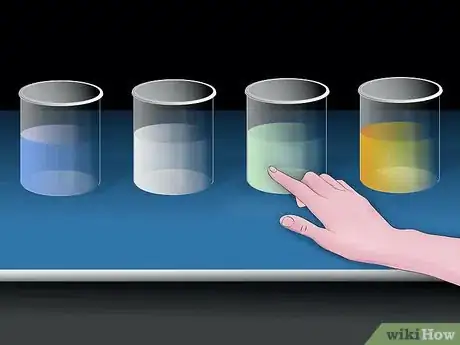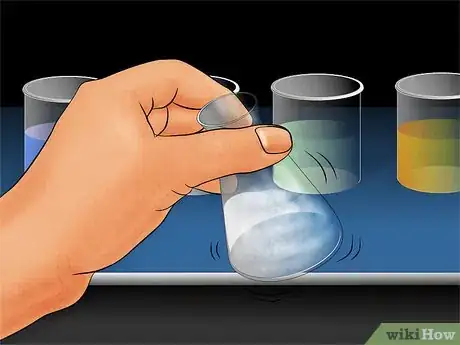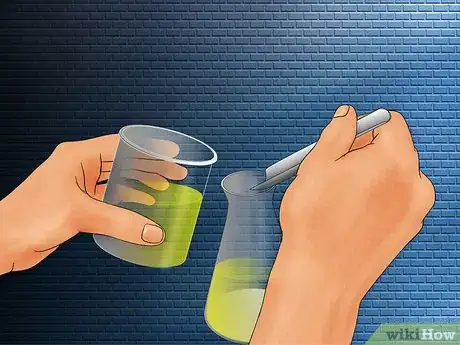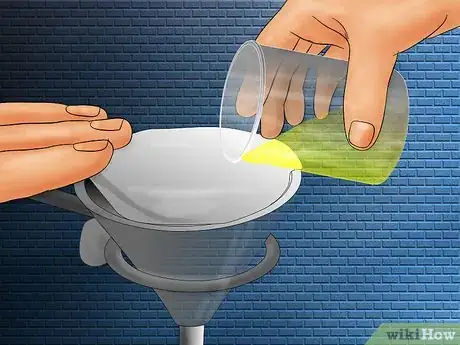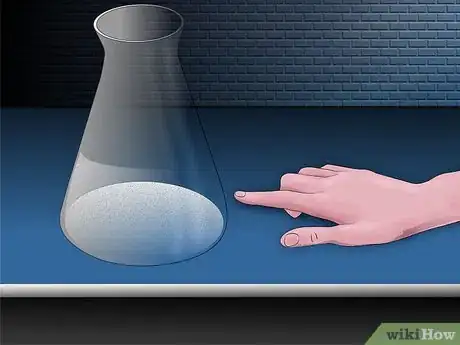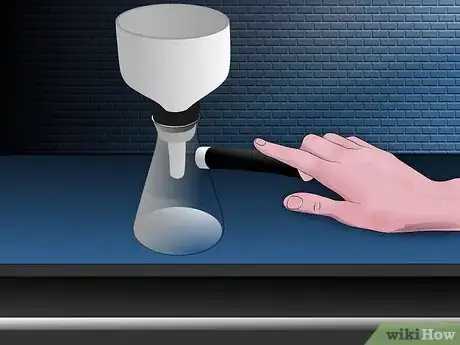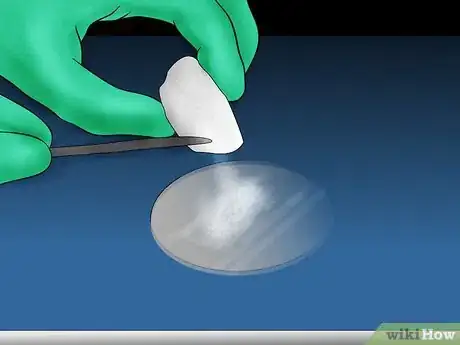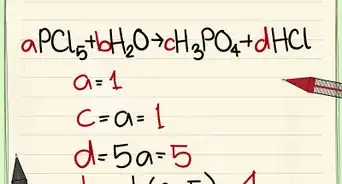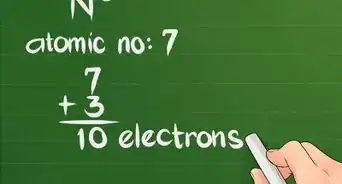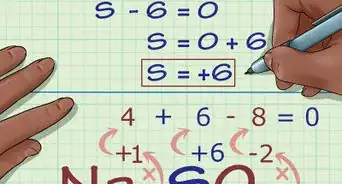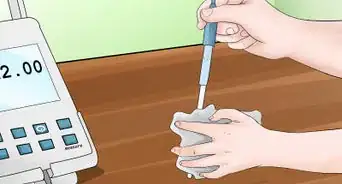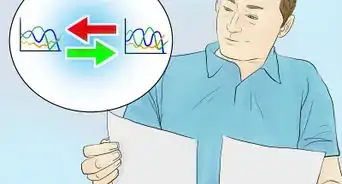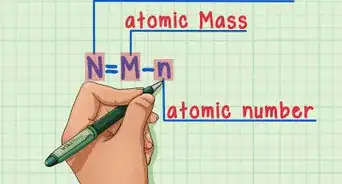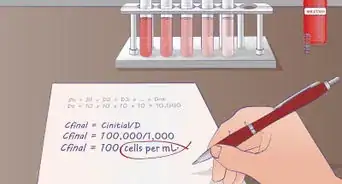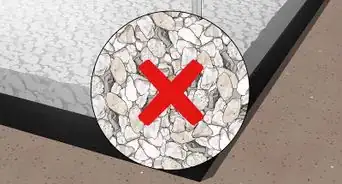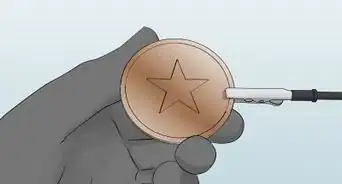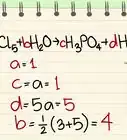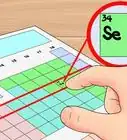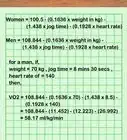wikiHow is a “wiki,” similar to Wikipedia, which means that many of our articles are co-written by multiple authors. To create this article, 26 people, some anonymous, worked to edit and improve it over time.
There are 9 references cited in this article, which can be found at the bottom of the page.
This article has been viewed 327,150 times.
Learn more...
Crystallization (or recrystallization) is the most important method for purification of organic compounds. The process of removing impurities by crystallization involves dissolving a compound in an appropriate hot solvent, allowing the solution to cool and become saturated with the compound being purified, allowing it to crystallize out of the solution, isolating it by filtration, washing its surface with cold solvent to remove residual impurities, and drying.[1]
This is best done in a controlled chemistry laboratory, in a well-ventilated area. Note that this procedure has wide applications, including large scale commercial purification of sugar by crystallization of the raw sugar product which leaves impurities behind.[2]
Steps
-
1Know what makes an appropriate solvent. Remember the dictum "like dissolves like": polar compounds dissolve in polar solvents, nonpolar compounds dissolve in nonpolar solvents. For example, sugar and salt (polar compounds) dissolve in water (polar solvent), but not in oil (nonpolar solvent).[3]
- The ideal solvent would have these properties:
- It will dissolve the compound when the solution is hot but not when the solution is cold.
- It will either not dissolve the impurities at all (so they can be filtered out when the impure compound is dissolved), or such that it will dissolve them very well (so they will remain in solution when the desired compound is crystallized out).
- It will not react with the compound.
- It is nonflammable.
- It is nontoxic.
- It is cheap.
- It is very volatile (so it can be removed easily from the crystals).
- The ideal solvent would have these properties:
-
2Consider your options. It is often difficult to decide upon the best solvent; the solvent is often chosen by experimentation, or by using the most non-polar solvent available. Familiarize yourself with the following list of common solvents (from most polar to least polar). Note that solvents adjacent to one another are miscible (they will dissolve in each other). Commonly used solvents are in bold.[4]
- Water (H2O) is nonflammable, nontoxic, cheap, and will dissolve many polar organic compounds; its drawback is high boiling point (100 °C (212 °F)), making it relatively nonvolatile and difficult to remove from crystals unless they are vacuum-dried in a desiccator.
- Acetic acid (CH3COOH) is useful for oxidation reaction, but will react with alcohols and amines, and is therefore difficult to remove (boiling point is 118 °C (244 °F)).
- Dimethyl sulfoxide (DMSO), methyl sulfoxide (CH3SOCH3) is used mainly as solvent for reactions; rarely for crystallization. It boils at 189 °C (372 °F), and is hard to remove.
- Methanol (CH3OH) is a useful solvent that will dissolve compounds of higher polarity than will other alcohols. Boiling point: 65 °C (149 °F).
- Acetone (CH3COCH3) is an excellent solvent; its drawback is low boiling point of 56 °C (133 °F), allowing little difference in solubility of a compound at its boiling point and room temperature.
- Butanone (methyl ethyl ketone, MEK) (CH3COCH2CH3) is an excellent solvent with boiling point 80 °C (176 °F).
- Ethyl acetate (CH3COOC2H5) is an excellent solvent with boiling point 78 °C (172 °F).
- Dichloromethane, methylene chloride (CH2Cl2) is useful as a solvent pair with ligroin, but its boiling point, 35 °C (95 °F), is too low to make it a good crystallization solvent. It can, however, be cooled down to −78 °C (−108 °F) using a dry ice/acetone bath,
- Diethyl ether (CH3CH2OCH2CH3) is useful as a solvent pair with ligroin, but its boiling point, 35 °C (95 °F), is too low to make it a good crystallization solvent, unless used with a dry ice/acetone bath.
- Methyl tert-butyl ether (CH3OC(CH3)3) is cheap, good replacement for diethyl ether given its higher boiling point, 52 °C (126 °F).
- Dioxane (C4H8O2) is easy to remove from crystals; mild carcinogen; forms peroxides; boiling point 101 °C (214 °F).
- Toluene (C6H5CH3) is an excellent solvent for crystallization of aryl compounds and has replaced the once commonly used benzene (a weak carcinogen); a drawback is high boiling point of 111 °C (232 °F), making it difficult to remove from crystals.
- Pentane (C5H12) is widely used for nonpolar compounds; often used as solvent pair with another solvent. Its low boiling point means that it's more useful when used in conjunction with a dry ice/acetone bath.
- Hexane (C6H14) is used for nonpolar compounds; inert; often used in a solvent pair; boiling point 69 °C (156 °F).
- Cyclohexane (C6H12) is similar to hexane, but cheaper, and has boiling point 81 °C (178 °F).
- Petroleum ether, also known as ligroin, is a mixture of saturated hydrocarbons of which pentane is a chief component; cheap, and used interchangeably with pentane; boiling point 30–60 °C (86–140 °F).
Advertisement -
3Choose your solvent:[5]
- Put a few crystals of the impure compound in a test tube and add a single drop of the solvent, allow it to flow down by the side of the tube.
- If the crystals dissolve immediately at room temperature, reject the solvent because too much of the compound will remain dissolved at low temperature, and try another solvent. If you're planning to cool your solvent significantly below room temperature during the re-crystallisation, (i.e. using a dry-ice/acetone bath), then perform this test using pre-cooled solvent.
- If the crystals do not dissolve in cold solvent, warm the tube on a hot sand bath or using a heat gun and observe the crystals. Add a drop more solvent if they do not dissolve. If they dissolve at the boiling point of the solvent and then crystallize again when cooled to room temperature, you have found an appropriate solvent. If not, try another solvent.
- If after a process of trial and error -- and no single satisfactory solvent is found -- use a solvent pair. Dissolve the crystals in the better solvent (the one in which they are readily dissolved), and add the poorer solvent to the hot solution until it becomes cloudy (the solution is saturated with the solute). The solvent pair must be miscible with each other. Some useful solvent pairs are acetic acid-water, ethanol-water, acetone-water, dioxane-water, acetone-ethanol, ethanol-diethyl ether, methanol-2Butanone, ethyl acetate-cyclohexane, acetone-ligroin, ethyl acetate-ligroin, diethyl ether-ligroin, dichloromethane-ligroin, toluene-ligroin.
-
4Dissolve the impure compound: To do so, place that compound in a test tube. Crush large crystals with a stirring rod to promote dissolving. Add the solvent drop by drop. To remove insoluble, solid impurities, use excess solvent to dilute the solution and filter out the solid impurities at room temperature (see step 4 for filtration procedure), then evaporate the solvent. Prior to heating, place a wood applicator stick in the tube to avoid super heating (heating of the solution above the solvent's boiling point without actually boiling). The air trapped in the wood will come out to form nuclei to allow even boiling. Alternatively, porous porcelain boiling chips may be used. After solid impurities have been removed and the solvent evaporated, add solvent drop by drop, while stirring the crystals with a glass rod and warming the tube on a steam bath or sand bath, until the compound is completely dissolved with minimal amount of solvent.[6]
- If you're working with a compound with a melting point lower than the boiling point of your solvent, make sure it hasn't melted without dissolving. If you see two liquid layers, add a little more solvent.
-
5Decolorize the solution. Skip this step if the solution is colorless or has only a light shade of yellow. If the solution is colored (which results from production of high-molecular weight by-products of chemical reactions), add excess solvent and activated charcoal (carbon), and boil the solution for a few minutes. The colored impurities will adsorb onto the surface of activated charcoal, due to its high degree of microporosity. Remove the charcoal with adsorbed impurities by filtration, as described in the next step.
-
6Remove solids by filtration. Filtration can be done by gravity filtration, decantation, or removal of solvent using a pipette. Generally, do not use vacuum filtration, as the hot solvent will cool during the process, allowing the product to crystallize in the filter. If there's no insoluble impurity, skip this step.[7]
- Gravity filtration: this is the method of choice for removing fine charcoal, dust, lint, etc. Get three Erlenmeyer flasks heated on a steam bath or hot plate: one containing the solution to be filtered, another one containing a few milliliters of solvent and a stemless funnel, and the third containing several milliliters of the crystallizing solvent to use for rinsing. Place a fluted filter paper (useful since you are not using vacuum) in a stemless funnel (stemless to prevent the saturated solution from cooling and clogging the stem with crystals) over the second Erlenmeyer flask. Bring the solution to be filtered to a boil, grasp it in a towel, and pour the solution into the filter paper. Add boiling solvent from the third Erlenmeyer flask to any crystals formed on the filter paper and to rinse the first Erlenmeyer flask that contained the solution being filtered, adding the rinse to the filter paper. Remove excess solvent by boiling the filtered solution.
- Decantation: This is used for large solid impurities (i.e. broken glass). Simply pour off (decant) the hot solvent, leaving the insoluble solids behind.
- Removal of solvent using a pipette: This is used for a small amount of solution and if the solid impurities are large enough. Insert a pipette with square tip into the bottom of the test tube (rounded bottom), and remove the liquid using suction, leaving solid impurities behind.
-
7Crystallize the compound of interest. This step assumes that any colored impurities and insoluble impurities have been removed by appropriate steps above. Remove any excess solvent by boiling it off or blowing it off with a gentle stream of air, or by rotary evaporation. Start from a solution saturated with the solute at the boiling point. Allow it to cool slowly to room temperature. Crystallization should begin. If not, initiate the process by adding a seed crystal or scratching the inside of the tube with a glass rod at the liquid-air interface. Once crystallization has begun, take care not to disturb the container to allow formation of large crystals. To promote slow cooling (which allows larger crystals to form), you can insulate the container with cotton or paper towels. Larger crystals are easier to separate from impurities. Once the container has completely cooled to room temperature, cool it in ice or other cooling bath for about five minutes to maximize the amount of crystals.[8]
- If, after cooling, you see two liquid layers, your compound has oiled out; in other words, it fell out of solution at a temperature above its melting point. This is especially likely to occur if you are working with a low-melting solid. In this case, add a little more solvent, reheat, and try again. Try adding a seed crystal (if available) or scratching the inside of container before cooling to encourage crystallisation to start.
-
8Collect and wash the crystals: To do this, separate the crystals from the ice-cold solvent by filtration. This can be done using the Hirsch funnel, the Buchner funnel, or by removal of the solvent using a pipette.[9]
- Filtration using the Hirsch funnel: Place the Hirsch funnel with non-fluted filter paper in a vacuum tight fitted flask. Place the filter flask in ice to keep the solvent cold. Wet the filter paper with the crystallization solvent. Hook the flask to an aspirator, turn on the aspirator, and ascertain that the filter paper is pulled down onto the funnel by the vacuum. Pour and scrape the crystals onto the funnel, and break the vacuum as soon as all liquid is removed from the crystals. Use a few drops of ice-cold solvent to rinse the crystallization flask and pour that onto the funnel while reapplying vacuum, and break the vacuum as soon as all liquid is removed from the crystals. Wash the crystals a few more times with ice-cold solvent to remove any residual impurities. At the end of washing, leave the vacuum on to dry the crystals.
- Filtration using the Buchner funnel: Place a piece of non-fluted filter paper in the bottom of the Buchner funnel, and wet it with solvent. Fit the funnel tightly against a filter flask via a rubber or synthetic rubber adapter to allow vacuum suction. Pour and scrape the crystals onto the funnel, and break vacuum as soon as the liquid is removed into the flask as the crystals are left on the paper. Rinse the crystallization flask with ice-cold solvent, add this to the washed crystals, reapply vacuum, and break vacuum when the liquid is removed from the crystals. Repeat and wash the crystals as many times as needed. Leave the vacuum on to dry the crystals at the end.
- Wash using a pipette: used for small amount of crystals to be washed. Insert a pipette with square tip into the bottom of the test tube (rounded bottom), and remove the liquid, leaving the washed solids behind.
-
9Dry the washed product: Final drying for a small amount of crystallized product can be done by squeezing the crystals between sheets of filter paper and allowing them to dry on a watch glass; alternatively, you can place them in a round-bottomed flask, and leave them on a vacuum line for about an hour.[10]
Community Q&A
-
QuestionWhy should warm pentane and ether solutions not be suction filtered?
 Community AnswerBoth are highly volatile and will boil into the aspirator or vacuum pump trap.
Community AnswerBoth are highly volatile and will boil into the aspirator or vacuum pump trap. -
QuestionHow do I start the crystallization of sugar?
 Gideon JamesCommunity AnswerIt starts with two major events: nucleation and crystallization. Clarified sugar cane juice is boiled in evaporators, which leaves a thick syrup. The syrup is then boiled at low temperatures, the seeding is added, and the product is then put in a centrifuge to separate the crystalline sugar and molasses. The seeding is what is most important, since that produces the nuclei.
Gideon JamesCommunity AnswerIt starts with two major events: nucleation and crystallization. Clarified sugar cane juice is boiled in evaporators, which leaves a thick syrup. The syrup is then boiled at low temperatures, the seeding is added, and the product is then put in a centrifuge to separate the crystalline sugar and molasses. The seeding is what is most important, since that produces the nuclei. -
QuestionWhich compound is the best for crystallization?
 NSEasternShoreChemistCommunity AnswerIf you want to practice, benzoic acid. It's very soluble in boiling water and very insoluble in ice-cold water. It's also rather nontoxic and no flammable solvents are involved.
NSEasternShoreChemistCommunity AnswerIf you want to practice, benzoic acid. It's very soluble in boiling water and very insoluble in ice-cold water. It's also rather nontoxic and no flammable solvents are involved.
Things You'll Need
- Organic compound for crystallization
- An appropriate solvent
- Test tubes or reaction containers
- Glass stirring rod
- Wood applicator stick, or porous porcelain boiling chips
- Activated charcoal (carbon)
- Steam bath or hot plate
- Erlenmeyer flasks
- Stemless funnel
- Fluted filter paper, and non-fluted for vacuum
- Pipettes
- Hirsch or Buchner funnel apparatus
- Watch glass
References
- ↑ https://chem.libretexts.org/Bookshelves/Organic_Chemistry/Book%3A_Organic_Chemistry_Lab_Techniques_(Nichols)/3%3A_Crystallization/3.1%3A_Overview_of_Crystallization
- ↑ https://www.gvsu.edu/labsafety/ventilation-70.htm
- ↑ http://www.wiredchemist.com/chemistry/instructional/laboratory-tutorials/recrystallization
- ↑ http://ccc.chem.pitt.edu/wipf/Web/Crystallization%20Solvents.pdf
- ↑ https://www.chemistryviews.org/details/education/2538901/Tips_and_Tricks_for_the_Lab_Growing_Crystals_Part_2.html
- ↑ https://chem.libretexts.org/Bookshelves/Physical_and_Theoretical_Chemistry_Textbook_Maps/Supplemental_Modules_(Physical_and_Theoretical_Chemistry)/Physical_Properties_of_Matter/Solutions_and_Mixtures/Case_Studies/RECRYSTALLIZATION
- ↑ https://orgchemboulder.com/Technique/Procedures/Filtration/Filtration.shtml
- ↑ http://www.orgchemboulder.com/Technique/Procedures/Crystallization/Crystallization.shtml
- ↑ http://web.mnstate.edu/jasperse/Chem355/Recrystallization-1.doc.pdf
